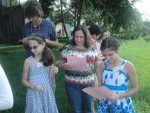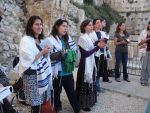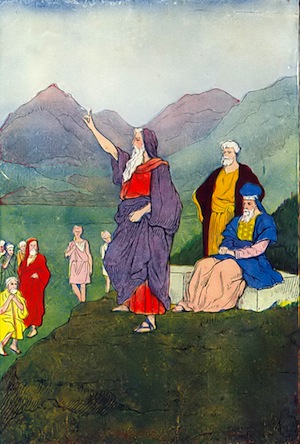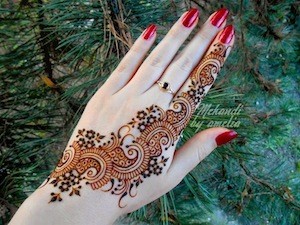As an alternative or addition to synagogue services, you could find a nice place outside in which to pray or reflect. (photo by Jan Lieberman via Wikimedia Commons)
There is a lot of beauty to the traditional synagogue experience. However, a traditional High Holidays service just does not speak to some, especially many young adults.
“Buying seats for the High Holidays is super-expensive,” said Rachel Moses, a marketer for a Jewish nonprofit from Mt. Washington, Md. “It also just doesn’t feel like it’s my place.”
If you think like Moses, consider skipping the tickets, and celebrating Rosh Hashanah and Yom Kippur outside the traditional four walls of your family synagogue. Here are nine alternative ways to connect to the High Holidays without stepping foot in a shul.
- Build community
Thomas Arnold, who works in Homeland Security and is from Pikesville, Md., says people often interpret Yom Kippur as a heavy day of repentance. In contrast, the day’s prohibitions – things like fasting, not wearing leather footwear, not making love to your partner, refraining from taking a bath – are intended to help us think less about our own needs and more about those of others.
“The point is to understand there are people that don’t have food, that don’t have water, that don’t have shoes to wear,” said Arnold, citing the 18th-century ethical Jewish book Mesillat Yesharim: The Path of the Upright by Italian rabbi and philosopher Moshe Hayyim Luzzatto. “We don’t have sex because there are people in the world who don’t have partners and cannot connect in that way.”
Arnold looks for people who are in need, lacking something or are lonely, and makes a point of giving to them during the High Holiday season. Sometimes, he invites them over for a meal, and other times he just lends them a helping hand.
“On Rosh Hashanah and Yom Kippur, make it about other people,” he said.
- Host a meal
Rabbi Jessy Gross, named by the Forward as one of the most inspiring rabbis of 2016, said some of her best holiday memories are not from the synagogue, but from places where people came together, like at her holiday table.
“Having meals with other people, especially if the person hosting can serve traditional Jewish foods, creates an opportunity … to celebrate Jewish food and culture,” said Gross.
Shari Seidman Klein of Beit Shemesh in Israel agrees. She cooks a holiday meal for her family, as well as for her children, a few of whom choose not to attend traditional activities. Apples and honey, round raisin challah and other sweet things bring the kids and their friends back to her dining room each year.
- Change something
Klein said she often instructs her Hebrew school students, many of whom are products of intermarriage, to use the High Holidays as a time to better themselves. She tells them, “Take on one thing for one day.”
For example, rather than fasting on Yom Kippur, she recommended giving up candy, soda or something else they like to eat. Older individuals might decide to give up the personal comfort of watching TV, or they might make the higher commitment of refraining from talking badly about others.
“It’s the idea of tikkun olam, bettering the world,” said Klein. “That one thing on that one day can take you back to the basics of being – and thinking.”
- Do Tashlich
One of Gross’ favorite rituals is Tashlich, for which all a person needs is access to a body of natural water such as a creek, pond or river. She recommends taking some bread or crackers and spending some time by the water meditating or journaling.
“I like to think about where I have missed the mark or haven’t reached my potential and cast this out,” she said. “It is great opportunity to … think about what you want as we evolve into the coming year. It’s a process of spiritual cleansing and preparedness.”
- Form a minyan
The Israeli organization Tzohar has been working to bring together the religious and secular Jewish communities in the Jewish state. In the central city of Lod, Tzohar’s executive vice-president, Yakov Gaon, said his organization found that many secular Israelis refrain from going to synagogue, not because they don’t want to pray, but because the service is too fast, politicized, costly or uncomfortable.
“They don’t know how to dress, when to stand up or sit down,” Gaon said.
About 15 years ago, Tzohar began creating alternative minyans in community centres, schools and gyms. The services bring like-minded people together. Each service is assigned a leader who announces the prayer page numbers to read, and explains what’s happening in the prayers. Today, more than 56,000 people take part in these Yom Kippur services at 300 locations across Israel. An additional 1,500 people attend one of Tzohar’s 60 Rosh Hashanah services.
- Go to Israel
While it may be too late now to book a trip, in general, traveling to Israel on or around the High Holidays is a more special experience than traveling there during nearly any other time of year, said Arnold, whose daughter is studying in Israel for the year.
Arnold said Israelis have a reputation for being rude or pushy, but during the Hebrew month of Elul – this month, which leads up to Rosh Hashanah – Israelis tend to mellow out.
“It’s like they know it instinctively,” Arnold said with a laugh. “Their Jewish souls come out and they know it is the Yamim Noraim (High Holy Days) and they better get themselves together.”
The whole country prepares with holiday festivals, music, delicious holidays foods and smells, he said.
- Host discussion
Skipping the rabbi’s sermon? Write your own, and invite others to hear it. Klein has tapped into several online resources, such as myjewishlearning.com, to provide fodder for discussion at the table, or for her son and his friends to discuss in an intimate setting. Gross, too, said that using online content and hosting a discussion group can help you learn about the holiday, and then share those insights with others.
- Reflect in Elul
There is still time to make an Elul reflection calendar. Create a pie chart divided by the Hebrew months, said Gross. Break each pie down by the number of days in that month. On each slice, record a guided meditation question or something you want to work on. Then, every morning or before bed, read it and reflect.
Here, too, Gross added, there are plenty of online trigger questions if you need guidance.
- Have a picnic
Mt. Washington’s Moses said hosting or attending a holiday picnic brings people together, offering a venue to eat traditional foods and also spend time in nature. While the children are playing, the adults can host the aforementioned discussion group, or meditate under the open sky.
- Pray outside
In general, being outside is a good way to infuse spirituality into your holiday. Transform your backyard, a park or a forest into a synagogue and pray.
Most years, Moses attends Baltimore Hebrew Congregation’s Rosh Hashanah Under the Stars program, which offers an alternative Jewish New Year get-together for members and non-members.
“There are thousands of people there, right under the stars, with no ceiling above you,” said Moses. “You feel like you are one with nature, with each other and with God – whatever sense of God there is.”
On years she cannot make the service, she and her family might travel to Ocean City, Md., instead. “We’ll just sit there and listen to the ocean,” she said.
To read more from JNS.org, click here.








